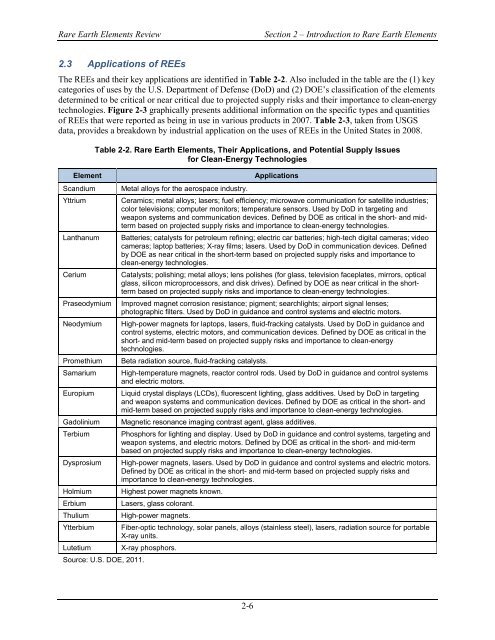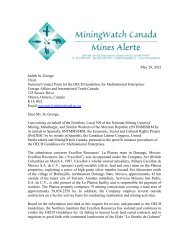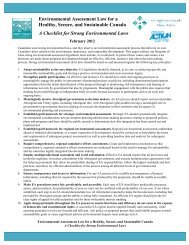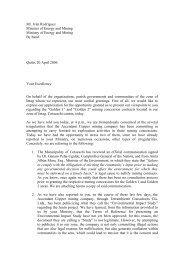Rare Earth Elements: A Review of Production, Processing ...
Rare Earth Elements: A Review of Production, Processing ...
Rare Earth Elements: A Review of Production, Processing ...
You also want an ePaper? Increase the reach of your titles
YUMPU automatically turns print PDFs into web optimized ePapers that Google loves.
<strong>Rare</strong> <strong>Earth</strong> <strong>Elements</strong> <strong>Review</strong><br />
Section 2 – Introduction to <strong>Rare</strong> <strong>Earth</strong> <strong>Elements</strong><br />
2.3 Applications <strong>of</strong> REEs<br />
The REEs and their key applications are identified in Table 2-2. Also included in the table are the (1) key<br />
categories <strong>of</strong> uses by the U.S. Department <strong>of</strong> Defense (DoD) and (2) DOE’s classification <strong>of</strong> the elements<br />
determined to be critical or near critical due to projected supply risks and their importance to clean-energy<br />
technologies. Figure 2-3 graphically presents additional information on the specific types and quantities<br />
<strong>of</strong> REEs that were reported as being in use in various products in 2007. Table 2-3, taken from USGS<br />
data, provides a breakdown by industrial application on the uses <strong>of</strong> REEs in the United States in 2008.<br />
Element<br />
Table 2-2. <strong>Rare</strong> <strong>Earth</strong> <strong>Elements</strong>, Their Applications, and Potential Supply Issues<br />
for Clean-Energy Technologies<br />
Applications<br />
Scandium Metal alloys for the aerospace industry.<br />
Yttrium Ceramics; metal alloys; lasers; fuel efficiency; microwave communication for satellite industries;<br />
color televisions; computer monitors; temperature sensors. Used by DoD in targeting and<br />
weapon systems and communication devices. Defined by DOE as critical in the short- and midterm<br />
based on projected supply risks and importance to clean-energy technologies.<br />
Lanthanum Batteries; catalysts for petroleum refining; electric car batteries; high-tech digital cameras; video<br />
cameras; laptop batteries; X-ray films; lasers. Used by DoD in communication devices. Defined<br />
by DOE as near critical in the short-term based on projected supply risks and importance to<br />
clean-energy technologies.<br />
Cerium Catalysts; polishing; metal alloys; lens polishes (for glass, television faceplates, mirrors, optical<br />
glass, silicon microprocessors, and disk drives). Defined by DOE as near critical in the shortterm<br />
based on projected supply risks and importance to clean-energy technologies.<br />
Praseodymium Improved magnet corrosion resistance; pigment; searchlights; airport signal lenses;<br />
photographic filters. Used by DoD in guidance and control systems and electric motors.<br />
Neodymium High-power magnets for laptops, lasers, fluid-fracking catalysts. Used by DoD in guidance and<br />
control systems, electric motors, and communication devices. Defined by DOE as critical in the<br />
short- and mid-term based on projected supply risks and importance to clean-energy<br />
technologies.<br />
Promethium Beta radiation source, fluid-fracking catalysts.<br />
Samarium High-temperature magnets, reactor control rods. Used by DoD in guidance and control systems<br />
and electric motors.<br />
Europium Liquid crystal displays (LCDs), fluorescent lighting, glass additives. Used by DoD in targeting<br />
and weapon systems and communication devices. Defined by DOE as critical in the short- and<br />
mid-term based on projected supply risks and importance to clean-energy technologies.<br />
Gadolinium Magnetic resonance imaging contrast agent, glass additives.<br />
Terbium Phosphors for lighting and display. Used by DoD in guidance and control systems, targeting and<br />
weapon systems, and electric motors. Defined by DOE as critical in the short- and mid-term<br />
based on projected supply risks and importance to clean-energy technologies.<br />
Dysprosium High-power magnets, lasers. Used by DoD in guidance and control systems and electric motors.<br />
Defined by DOE as critical in the short- and mid-term based on projected supply risks and<br />
importance to clean-energy technologies.<br />
Holmium Highest power magnets known.<br />
Erbium Lasers, glass colorant.<br />
Thulium High-power magnets.<br />
Ytterbium Fiber-optic technology, solar panels, alloys (stainless steel), lasers, radiation source for portable<br />
X-ray units.<br />
Lutetium X-ray phosphors.<br />
Source: U.S. DOE, 2011.<br />
2-6

















